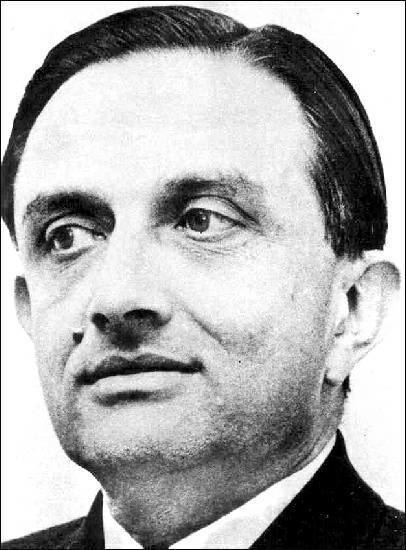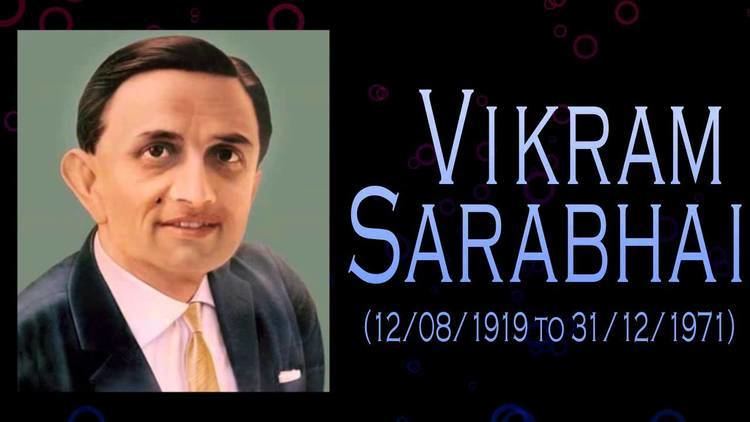Residence India Role Scientist Name Vikram Sarabhai | Nationality Indian Doctoral advisor C. V. Raman | |
 | ||
Institutions Indian Space Research OrganisationPhysical Research Laboratory Children Mallika Sarabhai, Kartikeya Sarabhai Similar People | ||
Biography of Vikram Sarabhai, Indian physicist, industrialist & father of India's space program
Vikram Ambalal Sarabhai (12 August 1919 – 30 December 1971) was an Indian scientist and innovator widely regarded as the father of India's space programme. Sarabhai received the Shanti Swarup Bhatnagar Medal in 1962. The nation honoured him awarding Padma Bhushan in 1966 and Padma Vibhushan (posthumously) in 1972.
Contents
- Biography of Vikram Sarabhai Indian physicist industrialist father of Indias space program
- Facts
- Dr vikram sarabhai space pioneer from india
- Personal life
- Professional life
- Darpana Academy of Performing Arts Ahmedabad
- Indian Institute of Management IIM Ahmedabad
- Distinguished positions
- Legacy
- References

Facts
Dr vikram sarabhai space pioneer from india
Personal life
Son of The Kumar Ambalal Sarabhai, he came from the famous Sarabhai family of India who were major industrialists committed to the Indian independence movement. Vikram Sarabhai married the classical dancer Mrinalini in 1942. The couple had two children. His daughter Mallika gained prominence as an actress and activist, and his son Kartikeya Sarabhai too became an active person in science. During his lifetime, he practiced Jainism and belonged to the Shrimal Jain community of Ahmedabad.
Professional life

Known as the cradle of space sciences in India, the Physical Research Laboratory (PRL) was founded in 1947 by Vikram Sarabhai. PRL had a modest beginning at his residence, the RETREAT, with research on cosmic rays.

The institute was formally established at the M.G. Science Institute, Ahmedabad, on 11 November 1947 with support from the Karmkshetra Educational Foundation and the Ahmedabad Education Society. Prof. Kalpathi Ramakrishna Ramanathan was the first Director of the institute. The initial focus was research on cosmic rays and the properties of the upper atmosphere. Research areas were expanded to include theoretical physics and radio physics later with grants from the Atomic Energy Commission.
Today PRL is actively involved in research, related to five major fields of science. PRL is also instrumental in the PLANEX planetary science and exploration programme.
The Vikram A. Sarabhai Community Science Centre (VASCSC), established in the 1960s by Sarabhai, worked towards popularizing science and mathematics education among students, teachers and the lay public. Its mandate is to stimulate interest, encourage and expose the principles of science and scientific method and also to improve and find innovative methods of science education.
The establishment of the Indian Space Research Organization (ISRO) was one of his greatest achievements. He convinced the Indian government of the importance of a space programme for a developing country like India after the Russian Sputnik launch. Sarabhai emphasized the importance of a space program as follows:
"There are some who question the relevance of space activities in a developing nation. To us, there is no ambiguilty of purpose. We do not have the fantasy of competing with the economically advanced nations in the exploration of the moon or the planets or manned space-flight. But we are convinced that if we are to play a meaningful role nationally, and in the community of nations, we must be second to none in the application of advanced technologies to the real problems of man and society."
Homi Jehangir Bhabha, widely regarded as the father of India's nuclear science program, supported Sarabhai in setting up the first rocket launching station in India. This center was established at Thumba near Thiruvananthapuram on the coast of the Arabian Sea, primarily because of its proximity to the equator. After a remarkable effort in setting up the infrastructure, personnel, communication links, and launch pads, the inaugural flight was launched on November 21, 1963 with a sodium vapour payload. As a result, the first Indian satellite, Aryabhata, was put in orbit in 1975 from a Russian Cosmodrome.
He led the Sarabhai family's diverse business conglomerate. His interests varied from science to sports to statistics. He set up Operations Research Group (ORG), the first market research organization in the country. Most notable among them are the Nehru Foundation for Development in Ahmedabad and the Indian Institute of Management Ahmedabad (IIMA), the Ahmedabad Textile Industry's Research Association (ATIRA) and the Center for Environmental Planning and Technology (CEPT). He also set up the Blind Men Association (BMA) which helps visually-challenged people. Along with his wife Mrinalini Sarabhai, he founded the Darpana Academy of Performing Arts. Other institutions established by him include the Faster Breeder Test Reactor (FBTR) in Kalpakkam, Variable Energy Cyclotron Project in Calcutta, Electronics Corporation of India Limited (ECIL) in Hyderabad and Uranium Corporation of India Limited (UCIL) in Jaduguda, Jharkhand.
As a result of Sarabhai's dialogue with NASA in 1966, the Satellite Instructional Television Experiment (SITE) was launched during July 1975 – July 1976 (after Sarabhai's death).
Sarabhai started a project for the fabrication and launch of an Indian satellite. As a result, the first Indian satellite, Aryabhata, was put in orbit in 1975 from a Russian cosmodrome.
Darpana Academy of Performing Arts, Ahmedabad
Darpana was established as a dance academy by Mrinalini and Vikram Sarabhai in 1949. For nearly two decades it taught classical dance. With Mrinalini as the lead dancer, and Chatunni Panicker as her partner, the Darpana dance company toured across the world. A few years later the great Kuchipudi guru, c R Acharyelu joined the faculty.
Indian Institute of Management (IIM), Ahmedabad
The decade following independence in 1947 was witness to a surge of innovative ideas to build a fledgling independent nation into a model democratic state committed to growth with equity in the development of its people. The establishment of Indian Institute of Management Ahmedabad (IIMA) was the outcome of one such innovative initiative.
Led by Vikram Sarabhai, Shri. Kasturbhai Lalbhai and supported by the then Chief Minister of Gujarat, Jivraj Mehta, a group of individuals set up IIMA. This group ably wove together a coalition of five factors — the governments at the centre and the state, the local industrialists, the Ford Foundation and the Harvard Business School, in a public private partnership to establish the Institute.
